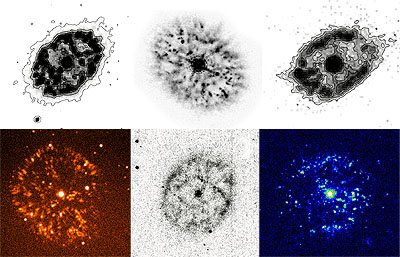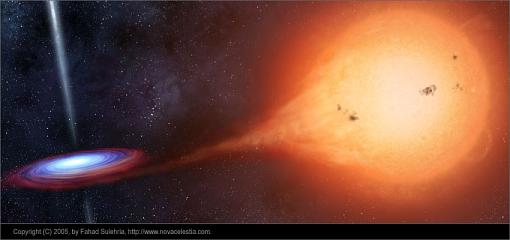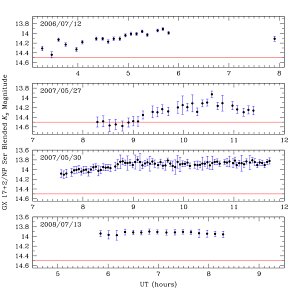



Classical Novae
A classical nova is thought to occur in a binary system consisting of a white dwarf accreting from a main sequence (or late type giant) via Roche Lobe overflow. The accreted material builds up as a layer on the surface of the white dwarf until the base temperature increases to the point when a thermonuclear runaway occurs, dominated by CNO reactions. This shell burning continues at Edddington luminosity for the white dwarf. Material is ejected at speeds from a few hundred to a thousand km/s. The shell starts as an optically thick fireball and expands and cools to be optically thin. Novae are classified by the speed at which they decrease in brightness. Classical novae are thought to recur every 10,000 years or so.
Some novae evidence a drop in optical/UV light with a corresponding increase in IR emission. This change represents the production of dust, which reprocesses the optical/UV light into infrared. It seems that fast novae do not, on average, produce dust, while slow novae can evidence optically thick or thin dust emission or none at all. However, a unified model of dust production does not exist to explain these difference scenarios.
 Images of classicl novae. Top row, left to right: DQ Her (Slavin 1995), HR Del (Harman & O'Brien 2003), T Aur (Slavin 1995). Bottom row, left to right: GK Per (NOAO), FH Ser (Gill & O'Brien 2000), T Pyx (Shara et al. 1997). |
X-ray Binaries
An X-ray binary is a system of two stars where one is a compact object accreting material from the other, and they are named for their large X-ray luminosities. The accretor is more evolved and has exhausted its nuclear fuel, existing as a stellar cinder like a neutron star or a black hole. The donor is usually a main sequence, giant, or supergiant star but can also be a white dwarf. In a High Mass X-ray Binary (HMXB) the primary accretes matter from the secondary's stellar wind. The secondary is usually an early type (young and massive) star with a strong stellar wind. In a Low Mass X-ray Binary (LMXB) the secondary is larger than its Roche Lobe, the surface of gravitational equipotential inside of which material is bound to the star. Material overflowing the Roche Lobe is attracted by the primary, again a compact object.
 Artist rendition of an X-ray binary. (Image credit: Astronomical Illustrations and Space Art by Fahad Sulehria) |
X-ray binaries have multiple sources of light at various wavelengths. The accretion disk itself usually overwhelms all other sources from visible to X-rays. The disk is thought to have a corona of tenuous hot gas which can reprocess (absorb and reemit) the accretion disk's X-rays as IR radiation. In LMXBs the donor would only contribute significantly to the IR, but in HMXBs it would be much more hot and luminous and contribute to visible and UV light. X-ray binaries are thought to have synchrotron jets (usually) perpendicular to the accretion disk, which are streams of relativistic plasma radiating across the spectrum from X-rays to radio. Due to the other competing bright sources of light, these jets are usually only observed in radio and hard X-rays and only in black hole systems. Synchrotron jets have been observed in X-ray binaries such as GRS 1915+105 (Fender et al. 1997), GX 339-4 (Corbel & Fender 2002), and XRB 4U 0614+091 (Migliari et al. 2006).
GX 17+2 is a LMXB in the constellation Serpens (near the galactic center). This system is also a Z source, meaning that the neutron star is accreting at or near the Eddington rate (accreting almost to the point where the energy released blows away the accreting material). Z sources are so named for the pattern they trace out on a X-ray color-color diagram, thought to relate to the ratio of the mass accretion rate and the average mass accretion rate (Hasinger & van der Klis 1989). GX 17+2 is one of the most active of the eight known Z sources. Its X-ray and radio activity seems correlated with radio brightness increasing from the NB to the HB (Penninx 1988, Migliari & Fender 2006), and it evidences the largest amplitude of rapid radio variations (Penninx 1989). Migliari & Fender (2006) found a correlation between radio and X-ray activity in Z sources in the hard X-ray state, where rapid state changes are associated with bright, optically thick, transient radio events (flares).
 K band light curves for four IR brightening events, defined as when the blend of GX 17+2 and the field star NP Ser is brighter than the resolved measurement of NP Ser itself, indicated by the line at 14.5. |
GX 17+2 demonstrates IR variations of an amazing 3 magnitudes in the K band (2.2 microns), which activity had never been seen in this source nor in any of the other Z sources. Intrigued by this unusual behavior, we studied this source for three years and accumulated the largest dataset of time-resolved IR light curves. We have detected 6 IR brightening events. Based on our data and that of Callanan et al. (2002), we have determined the IR brightening events to recur on a period of about 3 days. Futher, the light curves are not uniform in character, some having a sharp peak and others displaying a long plateau, or in peak magnitude.
These IR events are not associated with X-ray activity, implying that they are not caused by accretion disk events or coronal reprocessing. GX 17+2's IR variations are not due to eclipses, for the system brightens during the course of the event, which is fairly short in relation to the period. They cannot be due to mass ejection events (flares), for flares are stochastic in nature and our observed behavior is periodic.
We suspect GX 17+2 posses a precessing IR synchrotron jet. The 3 day period is a curiosity, for the standard model implies a stochastic jet. It is possible to explain these observations as a precessing synchrotron jet, as seen in BL Lacs (supermassive black holes at the centers of some galaxies), with only the inner disk precessing to allow it to have such a short period. We presume that we observe a chord of the conical jet as it precesses across our line of sight. This explains both the periodic and variable aspect of the observed IR brightening events. Current theoretical models predict such IR synchrotron radiation but also predict it will only be brighter than the reprocessed accretion disk corona emission for short-period systems (Migilari, et al. 2006). GX 17+2's orbital parameters are unknown, however.
This work has been published in ApJ Letters, "A Possible Period for the K-band Brightening Episodes of GX 17+2".
-
I am not teaching any lab sections at this time. I have been a TA for an undergraduate introduction to astronomy class (which amounts to running the lab portion of the course), a history of spaceflight course, and a course and life in the universe.
-
Observation
UT
Unisys Weather Enhanced Infrared Satellite Image (US), U of A GOES images/videos, Las Cruces Clear Sky Chart
APO: weather, NMSU 1m observing logs
KPNO: weather, lightening, staff, OA schedule, SQIID
IRTF: NSFCAM2, S/N calculator, limiting magnitude calculator, exposure time calculator
CTIO: ANDICAM (detector characteristics)
Spitzer: proposal submission guide
NRAO: VLA data archive, calibrator manual, guest house reservation
HEASARC: object visibility tool, search
Data reduction and display
SuperMongo
C programming reference, cfitsio
NR in C, NR public domain area
AWK primer
IRAF project homepage, manuals, recommended docs
ISIS
LaTeX: A&A, AAS: Macro pkg 4.0 journal abbreviations, AAS subject headings, Natbib references
symbols: Detexify LaTeX handwritten symbol recognition
The DIRTY model
Convertion & calculation
Astronomy tools, UKIRT astronomy tools
HEASARC general tools, date/time conversion, coordinate converter
Calendar converter
USNO Julian Date converter
HJD calculator
LST clock
Time zones
Hourly Airmass Table
Skycalc info & manual
Spitzer magnitude to Janskies
NED absorption law, IRSA reddening & extinction
NOAO instruments exp time calculator
eV to Hz
ADS Dexter help
Fahrenheit to Celcius
Bits to Bytes
Zamzar file conversion
Databases and Catalogs
9th Catalogue of Spectroscopic Binary Orbits (use GCVS cat)
CV Cat updated regularly
Ritter & Kolb updated regularly from literature searches
Downes & Shara not updated
Stellar colors
SIMBAD
STScI DSS
NASA/IPAC Infrared Science Archive meta data set search
IRSA: 2MASS Point Source Catalog, Gator Catalog; MSX
IR Surveys: VISTA (exposure time calculator), DENIS
STSci Digital Sky Survey
SDSS
USNO Image and Catalog Archive
HEASARC Data Archive, ASM MIT page, ASM lightcurves
Chandra Data Archive Observation Search
ROSAT All-Sky Survey
American Association of Variable Star Observers (AAVSO)
General Catalog of Variable Stars (GCVS)
RK catalog of CVs, LMXBs, etc.
Vizier Ritter 2010 catalog CVs, LMXBs, etc.
Downes' catalog
Information Bulletin on Variable Stars
Variable star types
Constellation Abbreviations
NIST Atomic Spectra Lines Database
CADC's International Astronomy Meeting List
Outreach and skywatching
Naval Observatory Sun & Moon for one day, Twilight calculator
Tonight's Sky observing plans
SEDS Messier catalog, constellation families
Jim Kaler's STARS information, constellations
Big Stars I, II
Star name translations
NASA Planetary Fact Sheets
Saturn & moons real time applet, any time applet
Jupiter & moons real time applet, any time applet
Journals
astro-ph
NASA ADS
ApJ
Nature
Fun
Homestuck
xkcd
Order of the Stick
explodingdog (tumblr)
APOD
Shirt Woot
LC Sun Daily Deals
Lolcats
CS Monitor, BoingBoing, Wired, Space.com
arXiv:astro-ph, Astrobites, GradHacker
BigHugeLabs' Mosaic Maker
Allen Theaters
What Bird
What's That Bug
Minerals by name
Latin fun
Victorian Flower
Language
Romaji dictionary, Mahou Japanese Dictionary
Calorie counters 1, 2
BabbleFish
Color Palette Generator from any image
Verizon PICS
All u c, YouTube
-
Fum and Gebra
Two IRNs conversing in French
Two IRNs and cell phone
IRN wants a kiss from a cockatiel, Cute IRNs speaking French
Squeeky Sleeping
Can't stay awake
Sparky 1, 2
Kookaburra 1,2
Izzie Brand New Dance
Where the Hell is Matt?
Techno Chicken
Cockatiel singing tune from Kill Bill (this is actually for my bird, not for me)
